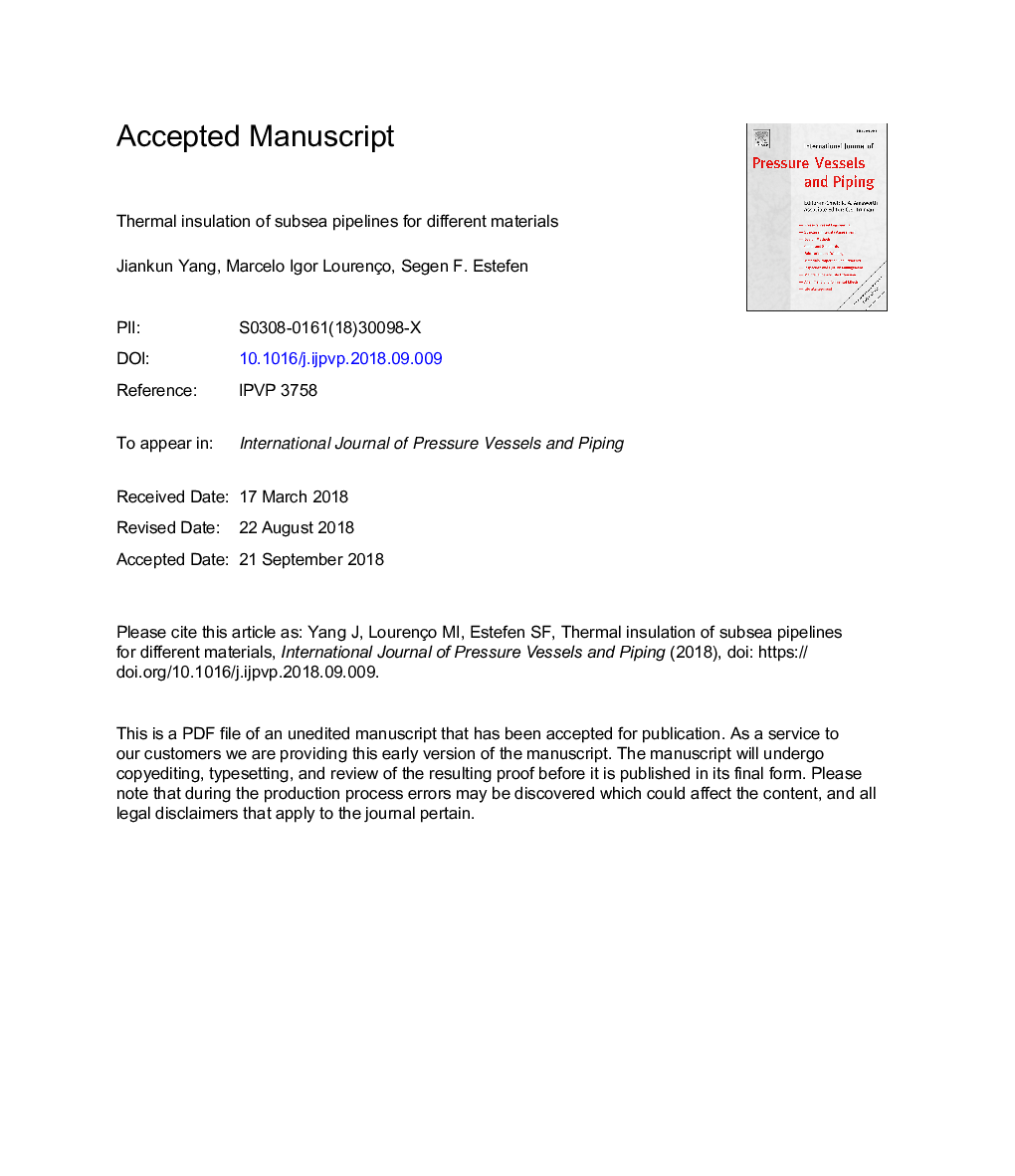| کد مقاله | کد نشریه | سال انتشار | مقاله انگلیسی | نسخه تمام متن |
|---|---|---|---|---|
| 11028802 | 1646709 | 2018 | 20 صفحه PDF | دانلود رایگان |
عنوان انگلیسی مقاله ISI
Thermal insulation of subsea pipelines for different materials
ترجمه فارسی عنوان
عایق حرارتی لوله های زیرزمینی برای مواد مختلف
دانلود مقاله + سفارش ترجمه
دانلود مقاله ISI انگلیسی
رایگان برای ایرانیان
کلمات کلیدی
سیستم تولید زیرزمینی، توزیع عایق، بهینه سازی، تکنیک یادگیری ماشین، الگوریتم ژنتیک، بهینه سازی ذرات ذرات،
ترجمه چکیده
عایق حرارتی به طور گسترده ای در تولید نفت دریایی برای طراحی اطمینان جریان استفاده می شود. تلاش های تحقیقاتی بر خواص حرارتی و مکانیکی مواد عایق متمرکز شده است، اما تعداد کمی از نشریات بر روی بهینه سازی عایق متمرکز شده اند. برای بعضی از سیستم های تولید زیرزمینی، چند مواد عایق اجباری در دسترس هستند. توزیع عایق در امتداد یک سیستم زیرزمینی برای رفع نیازهای حرارتی منحصر به هر ماده عایق نیست. طراحی های عایق بندی شده به صورت دستی اغلب منجر به رویکرد محافظه کارانه می شود که مواد بیشتر از موارد ضروری مصرف می کند. برای به دست آوردن یک طرح ارزان تر، یک روش بهینه سازی همراه با تکنیک های یادگیری ماشین ارائه شده است. سیستم تولید زیردریایی با استفاده از مواد عایق بندی مختلف در مورد مطالعه مورد بررسی قرار گرفته و نتایج بهینه سازی مورد بحث قرار گرفته است. چهار مواد مختلف عایق مورد استفاده قرار می گیرند و 2000 مدل برای هر ماده برای آماده سازی داده های آموزشی برای الگوریتم یادگیری ماشین شبیه سازی شده است. الگوریتم آموزش داده شده قادر به پیش بینی حداقل دمای سیستم با یک خطای کوچکتر از 5/5٪ است. الگوریتم ژنتیک و بهینه سازی ذرات ذرات برای یافتن توزیع کننده ترین عایق برای هر ماده مورد استفاده قرار می گیرند. هزینه های بهینه شده مربوط به هر ماده عایق سپس مقایسه می شود. نتایج نشان می دهد که روش پیشنهادی قادر به تعیین تغییرات مواد و ضخامت در سیستم زیرزمینی با هدف کاهش هزینه ها است.
موضوعات مرتبط
مهندسی و علوم پایه
سایر رشته های مهندسی
مهندسی مکانیک
چکیده انگلیسی
Thermal insulation is widely used in offshore oil production for flow assurance design. Research efforts have concentrated on the thermal and mechanical properties of the insulation material, but few publications have focused on the optimization of the insulation. For certain subsea production systems, several optional insulation materials are available. The distribution of insulation along a subsea system to fulfill thermal requirements is not unique to each insulation material. Manually defined insulation designs often lead to a conservative approach that consumes more material than necessary. To find the most economical design, an optimization method combined with machine learning techniques is presented. A subsea production system using different insulation materials is assessed in the case study and optimization results are discussed. Four different insulation materials are used, and 2000 models are simulated for each material to prepare the training data for the machine learning algorithm. The trained algorithm is able to predict the minimum temperature of the system with an error smaller than 5.5%. Genetic algorithm and particle swarm optimization are used to find the most efficient insulation distribution for each material. The optimized costs related to each insulation material are then compared. The results show that the proposed method is capable of defining material and thickness variations throughout the subsea system with the aim of reducing costs.
ناشر
Database: Elsevier - ScienceDirect (ساینس دایرکت)
Journal: International Journal of Pressure Vessels and Piping - Volume 168, December 2018, Pages 100-109
Journal: International Journal of Pressure Vessels and Piping - Volume 168, December 2018, Pages 100-109
نویسندگان
Jiankun Yang, Marcelo Igor Lourenço, Segen F. Estefen,
